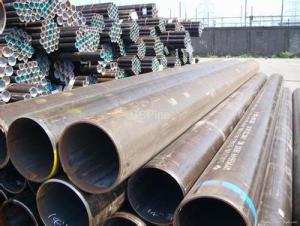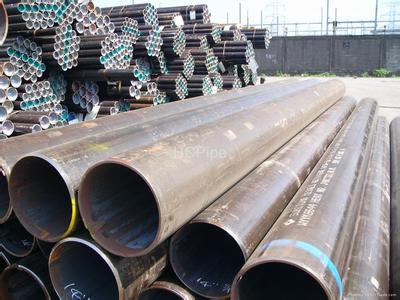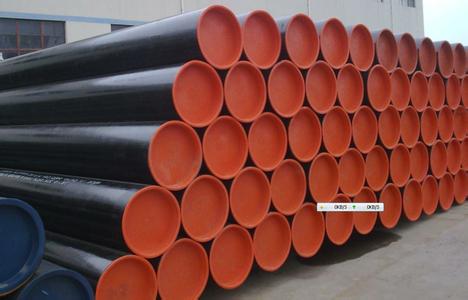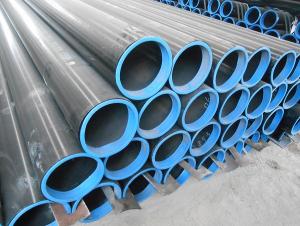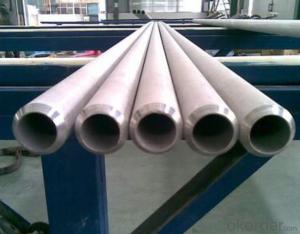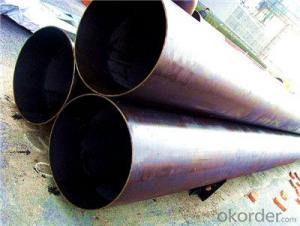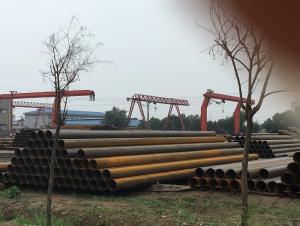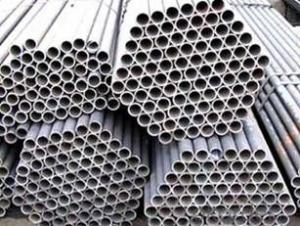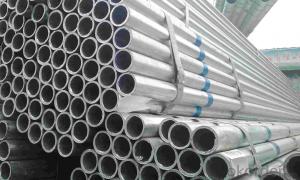High grade seamless steel tube
- Loading Port:
- China Main Port
- Payment Terms:
- TT OR LC
- Min Order Qty:
- -
- Supply Capability:
- -
OKorder Service Pledge
OKorder Financial Service
You Might Also Like
Seamless pipe is a hollow section, no surrounding joint strip steel. The worldproduction of seamless pipe, a total of more than 5100 production plant more than 1850 companies in more than 110 countries under the production of oilpipe, which has more than 260 factory more than 170 companies in 44 countries under the.
Seamless tube with 1 structure (GB/T8162-2008) is used for seamless tubegeneral structure and mechanical structure.
Seamless pipe 2 fluid transport (GB/T8163-2008) is used for general seamless pipe conveying water, oil, gas and other fluid.
For low and medium pressure boiler seamless pipe 3 (GB3087-2008) is used in the manufacture of various structure of low and medium pressure boilersuperheated steam pipe, superheated steam pipe, boiling water pipe andlocomotive boiler flue tube, small pipe and brick arch tubes of high-quality carbon structural steel hot-rolled and cold drawn seamless pipe (rolling).
High pressure boiler seamless pipe with 4 (GB5310-2008) is used for heating surface tube boiler manufacturing high and higher pressure of high quality carbon steel, alloy steel and heat resisting stainless steel seamless pipe.
High pressure seamless tube with 5 chemical fertilizer equipment (GB6479-2000) is suitable for the work temperature of high quality carbon structural steel and alloy steel seamless tube of -40~400 DEG C, the working pressurefor chemical equipment and pipeline of 10~30Ma.
Seamless tube with 6 petroleum cracking (GB9948-2006) is applied to the oil refinery furnace tubes, heat exchangers and pipe seamless pipe.
Steel pipe 7 geological drilling (YB235-70) is for the Geological Department of the steel core drilling is used, according to use can be divided into the drill pipe, drill collar, core pipe, casing and sedimentation tubes.
Seamless tube with 8 diamond core drilling (GB3423-82) is used for seamlessdrill pipe, casing, Yan Xingan diamond core drilling.
9 oil drilling pipe (YB528-65) is used for seamless oil drilling internal upset ends or the outer thickening.
Seamless tube
Seamless tube
10 ships for carbon steel seamless pipe (GB5312-85)
China classification society rules for materials and welding -- ChineseClassification Society (CCS)
The Norway Classification Society (DNV) specification -- Norway Classification Society (DNV)
Lloyd's register of shipping (LR) specification -- British Lloyd's register of shipping (LR)
Germanischer Lloyd (GL) specification -- Germanischer Lloyd (GL)
American Bureau of shipping (ABS) specification - American Bureau of shipping (ABS)
Bureau Veritas (BV) specification - French Classification Society (BV)
The Italy Classification Society (RINA) specification, Italy Classification Society(RINA)
The Japanese classification society (NK) specification -- the Japaneseclassification society (NK)
The ship is making I level pressure piping, II level pressure piping, boiler and superheater for carbon steel seamless pipe. Carbon steel seamless pipe walltemperature does not exceed 450 degrees, alloy steel seamless pipe walltemperature more than 450 DEG C.
11 of automobile half shaft sleeve pipe seamless pipe (GB3088-82) is the manufacture of automobile half shaft sleeve and the driving bridge shell axis effective quality carbon structural steel and alloy structural steel hot-rolled seamless tube.
High pressure oil pipe with 12 diesel engine (GB3093-86) is a cold drawn seamless pipe manufacturing high-pressure diesel injection systems for.
With precision internal diameter seamless pipe 13 for hydraulic and pneumatic cylinder (GB8713-88) is the manufacture of hydraulic and pneumatic cylinderwith precision diameter with cold drawn or cold rolled precision seamless tube.
14 cold drawn or cold rolled precision seamless pipe (GB3639-83) is used fordimensional precision mechanical structure, hydraulic equipment, high and good surface finish of cold drawn or cold rolled precision seamless tube.Selection of precision seamless tube manufacturing mechanical or hydraulic equipment.
Stainless steel seamless tube with 15 structure (GB/T14975-2002) is widely used in chemical, petroleum, made of stainless steel hot-rolled textile, medical,food, machinery and other industrial anti-corrosion pipes and structural partsand components of a (extrusion, expansion) and cold drawing (rolling)seamless pipe.
Stainless steel seamless tube 16 fluid transport (GB/T14976-2002) is used for the transmission fluid made of stainless steel hot-rolled (extrusion, expansion)and cold drawing (rolling) seamless pipe.
17 special seamless tube is in addition to general seamless other cross section shapes of circular pipe outside the. According to the section of the steel pipe of different shapes and sizes can be divided into equal wall thickness of seamless pipe (codenamed D), unequal wall thickness of seamless pipe (codenamed BD), variable diameter special-shaped seamlesspipe (codenamed BJ). Shaped seamless pipe is widely used for variousstructural parts, tools and machinery parts.
Seamless steel tubes for 18 cryogenic pipe (GB/T18984-2003) is the use ofseamless steel tube for -45 to -195 DEG C low-temperature pressure vessellevel and low temperature heat exchanger tubes
General seamless tube is made with 10, 20, 30, 35 and 45 carbon steel 16Mnand 5MnV low alloy structural steel or 40Cr, 30CrMnSi, 45Mn2, 40MnB and other alloy steel hot-rolled or cold-rolled made. 10 and 20 low carbon steelseamless pipe is mainly used for fluid conveying pipeline. In 45, 40Cr in carbon steel seamless pipe used to make machine parts, such as automobile, tractorparts under stress. General seamless pipe to ensure the strength andflattening test. Hot rolled steel pipe in hot state or heat treatment delivery; cold with heat to heat treatment delivery. Seamless steel tubes for low and medium pressure boiler: used in the manufacture of a variety of low and medium pressure boiler, the superheated steam tube, boiling water pipe, superheated steam pipe, water wall tube and locomotive boiler flue tube, pipe and pipe arch bricks.
With high-quality carbon structural steel hot-rolled or cold-rolled seamless pipe(dial). Mainly used in 10, 20 steel manufacturing, in addition to ensure that the chemical composition and mechanical properties of the outer do pressure test,curling, flaring, flattening test. Hot rolled in hot state delivery, Leng Zha(allocated) to heat treatment delivery.
- Q: What are the different methods of repairing steel pipes?
- There are several methods for repairing steel pipes, including welding, pipe wrapping, pipe lining, and pipe bursting. Welding involves fusing the damaged sections of the pipe using heat and pressure. Pipe wrapping involves using a fiberglass or epoxy resin wrap to reinforce and seal the damaged areas. Pipe lining involves inserting a new pipe into the damaged one, creating a seamless and corrosion-resistant inner lining. Pipe bursting involves replacing the damaged pipe by using a bursting head to break it apart while simultaneously pulling a new pipe into place. The choice of method depends on the nature and extent of the damage, as well as other factors such as cost and accessibility.
- Q: Are steel pipes fire-resistant?
- Yes, steel pipes are fire-resistant. Steel is a non-combustible material, which means it does not burn or contribute to the spread of fire. Steel pipes have high melting points and can withstand extreme temperatures, making them highly resistant to fire. They are commonly used in various applications where fire protection is crucial, such as fire sprinkler systems, fire hydrant systems, and fire-resistant building structures. Additionally, steel pipes are also known for their durability and strength, which further enhances their fire resistance capabilities.
- Q: Can steel pipes be used for structural supports in buildings?
- Steel pipes have the capability to serve as structural supports in buildings. Their reputation for strength, durability, and ability to bear heavy loads is well-known. Their high tensile strength allows them to endure immense tension and compression without fracturing or distorting, making them an excellent choice for buildings that necessitate robust and stable supports. Steel pipes have numerous applications in construction, including as columns, beams, trusses, or even as the primary support for an entire structure. Moreover, they possess great versatility and can be easily fabricated and tailored to meet specific design requirements. Furthermore, steel pipes offer resistance to fire, corrosion, and pests, rendering them a dependable option for enduring structural support in buildings over the long term.
- Q: How are steel pipes used in industrial manufacturing processes?
- Steel pipes are commonly used in industrial manufacturing processes for various purposes such as transporting fluids, gases, and solids, as well as providing structural support. They are used in industries like oil and gas, construction, automotive, and chemical manufacturing. Steel pipes offer high durability, strength, and resistance to corrosion, making them ideal for handling harsh environments and high-pressure applications. Additionally, they can be easily welded, bent, and manipulated to fit specific requirements, allowing for efficient and cost-effective installations.
- Q: Can steel pipes be used for underground chemical pipelines?
- Yes, steel pipes can be used for underground chemical pipelines. Steel pipes are widely used in various industries, including the chemical industry, due to their durability, strength, and resistance to corrosion. When selecting steel pipes for underground chemical pipelines, it is important to choose the appropriate grade of steel that is resistant to corrosion from the specific chemicals being transported. Additionally, proper coating and lining techniques can further enhance the resistance of steel pipes to chemical corrosion. Regular inspection and maintenance are also necessary to ensure the integrity and safety of the underground chemical pipeline system.
- Q: How are steel pipes used in the construction of underground utilities?
- Steel pipes are commonly used in the construction of underground utilities due to their durability and strength. They are used to transport various substances such as water, gas, and sewage underground, ensuring efficient and reliable distribution. Steel pipes are resistant to corrosion and can withstand high pressure, making them ideal for underground applications where they need to withstand the weight of the soil and other environmental factors. Additionally, steel pipes are easy to install and maintain, making them a cost-effective choice for underground utility construction projects.
- Q: What are the common welding techniques used for steel pipes?
- The common welding techniques used for steel pipes include shielded metal arc welding (SMAW), gas metal arc welding (GMAW), flux-cored arc welding (FCAW), and submerged arc welding (SAW).
- Q: What are the different types of steel pipe connections for fire sprinkler systems?
- There are three main types of steel pipe connections for fire sprinkler systems: threaded connections, grooved connections, and welded connections. Threaded connections involve screwing the pipes together using threads on the ends of the pipes. Grooved connections use grooves on the pipe ends and couplings with matching grooves to connect the pipes. Welded connections involve permanently bonding the pipes together using heat and a welding process. Each type of connection has its advantages and may be used in different applications based on factors such as pipe size, system design, and installation requirements.
- Q: How do you calculate the pipe friction loss coefficient for steel pipes?
- To calculate the pipe friction loss coefficient for steel pipes, you need to consider several factors. One of the most common methods used is the Darcy-Weisbach equation, which relates the frictional head loss in a pipe to the flow rate, pipe diameter, pipe length, fluid properties, and the pipe roughness coefficient. The Darcy-Weisbach equation is expressed as: hf = (f * L * V^2) / (2 * g * D) Where: hf is the head loss due to friction, f is the pipe friction factor, L is the pipe length, V is the fluid velocity, g is the acceleration due to gravity, and D is the pipe diameter. The pipe friction factor, f, is the key parameter that needs to be determined. For steel pipes, this factor depends on the pipe roughness coefficient, which represents the relative roughness of the pipe. The relative roughness is calculated by dividing the absolute roughness of the pipe surface by the pipe diameter. The pipe roughness coefficient can be obtained from various sources, such as manufacturer specifications, engineering handbooks, or experimental data. It is important to ensure that the roughness coefficient used matches the specific type and condition of the steel pipe being analyzed. Once you have the pipe roughness coefficient, you can use it to calculate the pipe friction factor using empirical correlations or charts. These correlations often involve Reynolds number, which is a dimensionless quantity that characterizes the flow regime. By substituting the obtained pipe friction factor into the Darcy-Weisbach equation, you can calculate the head loss due to friction for steel pipes. This value is essential in designing piping systems, determining pump requirements, or estimating energy consumption in fluid flow applications.
- Q: How are steel pipes used in the manufacturing of pulp and paper mills?
- Steel pipes are commonly used in the manufacturing of pulp and paper mills for various purposes. They are primarily utilized for transporting water, chemicals, and steam throughout the mill's processes. Steel pipes are also employed for structural support, such as in the construction of storage tanks, conveyors, and equipment frames. Additionally, they are used for providing compressed air, ensuring efficient operation of machinery and processes. Overall, steel pipes play a crucial role in facilitating the smooth functioning and efficient production of pulp and paper mills.
Send your message to us
High grade seamless steel tube
- Loading Port:
- China Main Port
- Payment Terms:
- TT OR LC
- Min Order Qty:
- -
- Supply Capability:
- -
OKorder Service Pledge
OKorder Financial Service
Similar products
Hot products
Hot Searches
Related keywords
